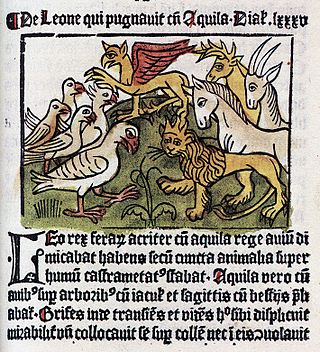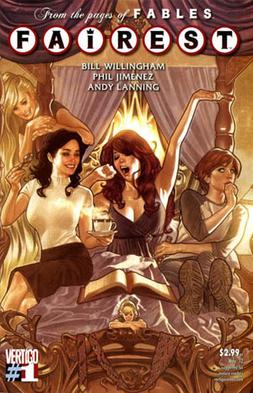
Fable is a literary genre: a succinct fictional story, in prose or verse, that features animals, legendary creatures, plants, inanimate objects, or forces of nature that are anthropomorphized, and that illustrates or leads to a particular moral lesson, which may at the end be added explicitly as a concise maxim or saying.

Reynard the Fox is a literary cycle of medieval allegorical Dutch, English, French and German fables. The first extant versions of the cycle date from the second half of the 12th century. The genre was popular throughout the Late Middle Ages, as well as in chapbook form throughout the Early Modern period.
An apologue or apolog is a brief fable or allegorical story with pointed or exaggerated details, meant to serve as a pleasant vehicle for a moral doctrine or to convey a useful lesson without stating it explicitly. Unlike a fable, the moral is more important than the narrative details. As with the parable, the apologue is a tool of rhetorical argument used to convince or persuade.

Uncle Remus is the fictional title character and narrator of a collection of African American folktales compiled and adapted by Joel Chandler Harris and published in book form in 1881. Harris was a journalist in post-Reconstruction era Atlanta, and he produced seven Uncle Remus books. He did so by introducing tales that he had heard and framing them in the plantation context. He wrote his stories in a dialect which was his interpretation of the Deep South African-American language of the time. For these framing and stylistic choices, Harris's collection has garnered controversy since its publication. Many of these stories are believed to have Creek Indian influence too.

Ysengrimus is a Latin fabliau and mock epic, an anthropomorphic series of fables written in 1148 or 1149, possibly by the poet Nivardus. Its chief character is Isengrim, the Wolf; the plot describes how the trickster figure Reynard, the Fox, overcomes Isengrim's various schemes.

The fox appears in the folklore of many cultures, but especially European and East Asian, as a figure of cunning, trickery, or as a familiar animal possessed of magic powers, and sometimes associated with transformation. Literature, film, television, games, music, and other forms of cultural expression may reflect the folklore image and reputation.
Beast poetry, in the context of European literature and medieval studies, refers to a corpus of poems written in Latin from the 8th to the 11th century.
French folklore encompasses the fables, folklore, fairy tales and legends of the French people.

Beasts is a novel by American writer John Crowley, published in 1976 by Doubleday.

Dialogus creaturarum, is a collection of 122 Latin-language fables and, as the title implies, dialogues of creatures.

The Morall Fabillis of Esope the Phrygian is a work of Northern Renaissance literature composed in Middle Scots by the fifteenth century Scottish makar, Robert Henryson. It is a cycle of thirteen connected narrative poems based on fables from the European tradition. The drama of the cycle exploits a set of complex moral dilemmas through the figure of animals representing a full range of human psychology. As the work progresses, the stories and situations become increasingly dark.

Br'er Rabbit is a central figure in an oral tradition passed down by African-Americans of the Southern United States and African descendants in the Caribbean, notably Afro-Bahamians and Turks and Caicos Islanders. He is a trickster who succeeds by his wits rather than by brawn, provoking authority figures and bending social mores as he sees fit. Popular adaptations of the character, originally recorded by Joel Chandler Harris in the 19th century, include Walt Disney Productions' Song of the South in 1946.

Anthropomorphism is the attribution of human traits, emotions, or intentions to non-human entities. It is considered to be an innate tendency of human psychology.

Aesop was a Greek fabulist and storyteller credited with a number of fables now collectively known as Aesop's Fables. Although his existence remains unclear and no writings by him survive, numerous tales credited to him were gathered across the centuries and in many languages in a storytelling tradition that continues to this day. Many of the tales associated with him are characterized by anthropomorphic animal characters.

Talking animals are a common element in mythology and folk tales, children's literature, and modern comic books and animated cartoons. Fictional talking animals often are anthropomorphic, possessing human-like qualities. Whether they are realistic animals or fantastical ones, talking animals serve a wide range of uses in literature, from teaching morality to providing social commentary. Realistic talking animals are often found in fables, religious texts, indigenous texts, wilderness coming of age stories, naturalist fiction, animal autobiography, animal satire, and in works featuring pets and domesticated animals. Conversely, fantastical and more anthropomorphic animals are often found in the fairy tale, science fiction, toy story, and fantasy genres.
The Ecbasis captivi is an anonymous Latin beast fable that probably dates to the middle of the 11th century, and was likely written in the Vosges region of France. It is the oldest example of a European beast fable to survive, and the first medieval European example of anthropomorphic animals. The poem is written in hexameters with Leonine internal rhyme frequently used throughout the poem. The text survives in two manuscripts, both of which now are at the Royal Library of Belgium.
An Entertaining Tale of Quadrupeds is a Byzantine poem composed in the 14th century AD by an unknown author. It is notable for its cross-genre literary style, encompassing satire, didactic and romance. The text takes the form of a dialogue between different domestic and wild animals, in a convention presided over by the King of the animals, the Lion.

Fairest is an American monthly comic series created by Bill Willingham, published by DC's Vertigo. A spin-off of Fables, Fairest detailed the adventures and stories of Fabletown's female citizens and heroines. Fairest was described by Willingham as a series of miniseries, with each arc telling self-contained stories.

The Fox, the Wolf and the Husbandman is a poem by the 15th-century Scottish poet Robert Henryson and part of his collection of moral fables known as the Morall Fabillis of Esope the Phrygian. It is written in Middle Scots. As with the other tales in the collection, appended to it is a moralitas which elaborates on the moral that the fable is supposed to contain. However, the appropriateness of the moralitas for the tale itself has been questioned.